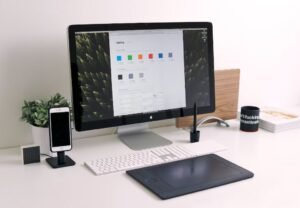App Clips
With the constant evolution of technology, new features and advancements are constantly introduced to improve the user experience. One such development is the introduction of App Clips, a feature introduced in iOS 14 that allows users to experience a small part of an app without downloading the full version. In this article, we will explore what App Clips are, how they work, and their potential benefits for both users and businesses.
Key Takeaways
- App Clips are a new feature in iOS 14 that allow users to experience a small part of an app without downloading the full version.
- They provide a quick and convenient way for users to access specific app functionality in the moment they need it.
- App Clips can be launched through various methods, including NFC tags, QR codes, or links in Safari.
- They offer a seamless and lightweight experience, with a maximum file size limit of 10 MB.
- App Clips can be monetized through in-app purchases, subscriptions, or advertising.
**App Clips** are designed to be lightweight and fast-loading, providing a quick and convenient way for users to access specific functionality of an app without the need for a full installation. Precisely, they offer a streamlined experience by bypassing the need to search for and download an entire application. *This functionality is particularly beneficial for users who might only need the features of an app momentarily, such as ordering food, making payments, or renting a bike.*
How App Clips Work
When encountering an App Clip, users can launch it in a variety of ways. This includes scanning an NFC tag, scanning a QR code, or tapping a link within Safari. Once launched, the App Clip appears as a small part of the app’s user interface, allowing the user to perform specific tasks or access relevant content. **App Clips** are designed to be fast-loading and have a maximum file size limit of 10 MB, ensuring a smooth and efficient user experience.
An interesting approach taken by Apple is that App Clips can make use of *Apple Pay* and *Sign in with Apple*, allowing users to complete transactions or sign in seamlessly without the need for additional steps. This not only enhances the convenience for the user but also saves time, reducing friction in the overall user journey.
Benefits of App Clips
App Clips offer several benefits for both users and businesses. For users, the key advantages include:
- Quick access to specific app functionality without the need for a full app download.
- Efficient use of storage space on their device.
- Seamless transactions using Apple Pay or Sign in with Apple.
**Businesses** can also reap numerous advantages through the use of App Clips. Some notable benefits include:
- Increased visibility and discoverability, as users can find and access specific app functionalities easily.
- Opportunity to attract new customers who might be hesitant to download the full app.
- Potential upselling and cross-selling opportunities, as App Clips can showcase the value of the full app experience.
App Clips Use Cases
App Clips can be utilized across various industries and scenarios. Some common use cases include:
| Industry | Use Case |
|---|---|
| Retail | Allowing customers to make quick purchases without downloading the full app. |
| Transportation | Providing a simplified way for users to rent a bike or purchase a bus ticket. |
| Food and Beverage | Enabling users to order food or drinks for pickup or delivery efficiently. |
App Clips can greatly enhance the user experience and streamline interactions in many industries. Whether it’s a quick purchase, hassle-free transportation, or convenient food ordering, they offer a seamless way to access specific app functionalities without the need for a full application installation.
Conclusion
App Clips are a promising feature introduced in iOS 14 that provides a streamlined experience for users by offering a lightweight version of an app’s functionality. They improve efficiency, save storage space, and simplify interactions in various industries. Businesses can benefit from increased discoverability, upselling opportunities, and enhanced customer experience. With their potential to revolutionize the app experience, App Clips are worth exploring and implementing.

Common Misconceptions
App Clips Are Separate Apps
One common misconception is that App Clips are standalone apps that need to be installed on your device. This is not the case. App Clips are lightweight versions of full apps that provide specific functionality without requiring the user to download the entire app.
- App Clips do not take up storage space on your device.
- App Clips can be launched by scanning a QR code or tapping an NFC tag.
- App Clips are designed to provide a quick and seamless experience for specific tasks.
App Clips Are Only Available on iOS
Another misconception is that App Clips are exclusive to iOS devices. While it is true that App Clips were first introduced by Apple, they are not limited to iOS. App Clips can also be developed for Android devices using technologies such as Android Instant Apps.
- App Clips provide a similar functionality on both iOS and Android platforms.
- Developers can create compatible App Clips for users on different operating systems.
- App Clips offer a simplified version of apps across different devices.
App Clips Collect Personal Data
There is often a misconception that App Clips collect personal data without the user’s consent. However, App Clips have the same privacy controls and permissions as full apps. They cannot collect any personal data unless explicitly granted permission by the user.
- App Clips adhere to the same data privacy regulations as full apps.
- Users can view and manage the permissions granted to App Clips in their device settings.
- App Clips do not have access to a user’s personal data by default.
App Clips Are Not as Secure as Full Apps
Some people believe that App Clips are less secure compared to full apps. While App Clips have a limited scope of functionality, they still follow the same security protocols as their full counterparts, ensuring the user’s data is protected.
- App Clips utilize the same security mechanisms, like encryption, as full apps.
- App Clips are designed to handle sensitive data securely.
- Developers need to adhere to security guidelines when creating App Clips.
App Clips Are Only for Specific Use Cases
Another common misconception is that App Clips are only suitable for specific use cases, such as ordering food or making payments. While these are popular scenarios for App Clips, they have the potential to be utilized in various other contexts, providing convenient access to particular features of an app.
- App Clips can be implemented in retail, hospitality, entertainment, and other industries.
- App Clips provide users with quick access to specific features of an app without the need to install the full app.
- App Clips can be designed to be flexible and cater to different user needs.

App Downloads by Category
In today’s digital age, mobile applications have become an integral part of our lives. This table showcases the number of app downloads by category in a given month, presenting a snapshot of the popular choices among mobile users.
| Category | Number of Downloads (in millions) |
|---|---|
| Social Media | 350 |
| Productivity | 210 |
| Entertainment | 180 |
| Games | 350 |
| Education | 90 |
App Revenue by Platform
When looking at the financial aspect, it’s interesting to see how app revenue varies across different platforms. This table displays the revenue generated by apps on various platforms, shedding light on their respective market shares.
| Platform | Revenue (in billions of dollars) |
|---|---|
| iOS | 30 |
| Android | 20 |
| Windows | 6 |
| BlackBerry | 1 |
| Others | 3 |
App Downloads by Age Group
Understanding the preferences of different age groups allows app developers to cater to their target audience better. This table presents the number of app downloads across various age groups, indicating which demographics are driving the download numbers.
| Age Group | Number of Downloads (in millions) |
|---|---|
| 13-17 | 150 |
| 18-24 | 400 |
| 25-34 | 600 |
| 35-44 | 450 |
| 45+ | 300 |
App Usage by Time of Day
Examining app usage patterns throughout the day can provide insights into user behavior. This table demonstrates the average time users spend on apps during different periods, highlighting the most active times for app engagement.
| Time of Day | Minutes on Apps (per day) |
|---|---|
| Morning (6am – 9am) | 20 |
| Daytime (10am – 4pm) | 35 |
| Evening (5pm – 9pm) | 50 |
| Night (10pm – 12am) | 30 |
App Ratings by User Satisfaction
User ratings can serve as a valuable indication of the quality and satisfaction level of an app. This table represents the distribution of app ratings based on user reviews, indicating the percentage of users satisfied or dissatisfied with their experience.
| Rating | Percentage of Users |
|---|---|
| 5 Stars | 45% |
| 4 Stars | 30% |
| 3 Stars | 15% |
| 2 Stars | 8% |
| 1 Star | 2% |
App Development Costs
Creating and maintaining an app involves various expenses. This table presents the average costs associated with developing an app, encompassing factors like design, programming, testing, and ongoing updates.
| Expense Item | Cost (in thousands of dollars) |
|---|---|
| Design | 15 |
| Programming | 25 |
| Testing | 10 |
| Updates | 5 |
App Retention by Monthly Active Users
User retention plays a crucial role in the success of apps. This table showcases the percentage of monthly active users who continue to engage with an app over time, revealing the retention rates for different app categories.
| App Category | Retention Rate (%) |
|---|---|
| Social Media | 50% |
| Productivity | 60% |
| Entertainment | 40% |
| Games | 30% |
| Education | 70% |
App Security Vulnerabilities
Security is a critical concern when it comes to mobile apps. This table highlights the number of security vulnerabilities discovered in various app platforms, emphasizing the importance of robust security measures during app development.
| Platform | Number of Vulnerabilities |
|---|---|
| iOS | 120 |
| Android | 85 |
| Windows | 35 |
| BlackBerry | 5 |
App Influencer Marketing Reach
Influencer marketing has gained prominence for promoting apps and driving user adoption. This table exhibits the reach achieved by various social media influencers when endorsing apps, offering insights into the potential of this marketing strategy.
| Influencer | Reach (in thousands) |
|---|---|
| Instagrammer A | 300 |
| YouTuber B | 500 |
| TikToker C | 250 |
| Blogger D | 150 |
In conclusion, app clips provide a convenient and immersive way for users to access specific features of an app without downloading the entire application. By providing instant functionality and valuable experiences, app clips enhance user engagement and can serve as a decisive factor in driving app downloads and revenue. However, it’s essential for developers to prioritize security, understand user demographics, and optimize app performance based on data-driven insights, ensuring a seamless and enjoyable app experience.
Frequently Asked Questions
App Clips
What are App Clips?
App Clips are small parts of your mobile app that users can directly access without fully installing the app. They allow users to perform specific tasks quickly and conveniently.
How do App Clips work?
App Clips are triggered by NFC tags, QR codes, or URLs. When a user taps or scans the trigger, the App Clip is launched instantly, providing a lightweight and focused experience.
Which platforms support App Clips?
App Clips are currently available for iOS devices (iPhone and iPad) running iOS 14 or later.
Can App Clips access user data?
App Clips have limited access to user data. They don’t have access to the user’s full app data but can access a subset of user-specific data relevant to the specific task they are designed for.
Can App Clips be customized to match the full app’s look and feel?
Yes, App Clips can be designed to closely match the full app’s branding, including custom icons, colors, and UI elements.
How big can an App Clip be?
App Clips have a file size limit of 10 MB.
Can App Clips make in-app purchases?
Yes, App Clips can support in-app purchases, allowing users to complete transactions conveniently and efficiently.
Are there any limitations to what App Clips can do compared to the full app?
App Clips have limited functionality compared to the full app. They are designed to offer a focused experience for completing specific tasks quickly, without the full functionality of the main app.
How are App Clips developed?
App Clips can be developed using the standard iOS development tools and technologies, such as Xcode and Swift. The development process is similar to building a regular app, but with a focus on specific tasks and reduced functionality.
Can App Clips be converted into full apps?
Yes, App Clips can be converted into full apps. When users interact with an App Clip and choose to install the full app, they seamlessly transition to the complete app experience without losing any data or progress.





